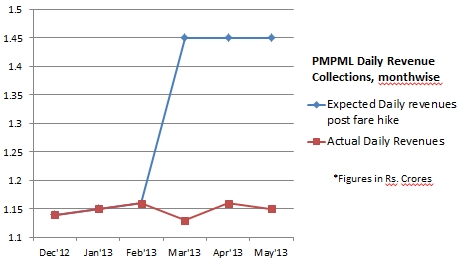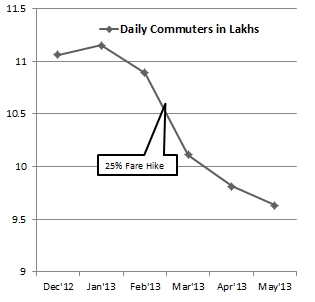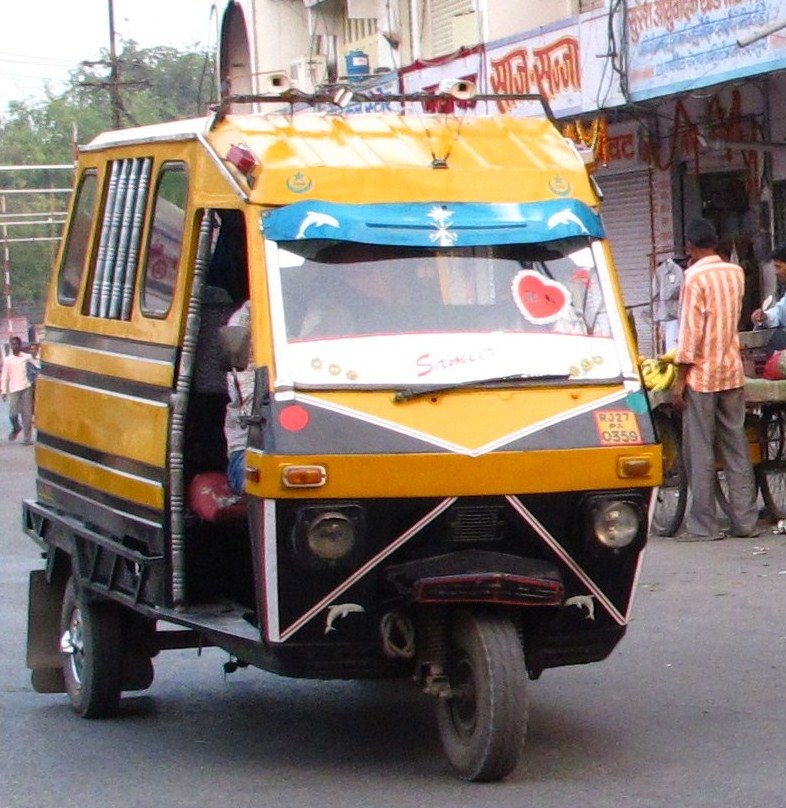Suggestions to address Pune's public transport issues
Nikhil VJ
Per day Per Bus Daily Commuters Daily Revenue
Dec 2012 845 11.06lakhs 1crore 14lakhs
Jan 2013 849 11.15lakhs 1crore 15lakhs
Feb 2013 821 10.89lakhs 1crore 16lakhs
After 25% Fare Hike [Anticipated] Daily Revenue
Mar 2013 767 10.11lakhs 1crore 13lakhs 1crore 45lakhs
Apr 2013 757 9.81lakhs 1crore 16lakhs 1crore 45lakhs
May 2013 772 9.63lakhs 1crore 15lakhs 1crore 45lakhs
(Pls see this in the word attachment shared by Bhanu-ji included in this email if you can't see the below one properly.)


From a systems perspective, this carries powerful inferences.
1. Pune's commuters, as an autonomous yet inter-related system (imagine they are the cells in a living organism), reacted non-linearly to the last major bus fare hike.
2. The commuters per day dropped.
3. This eliminated the PMPML's expected gains in revenue collection, which was based on the presumption that number of commuters would not change drastically. The linearly thought tweaking of the system backfired.
4. On the accounts side, it may look like "nothing changed". And that can give a sense of inertia too, to not change anything back. But there's more to this issue than just the account books. A worse chain of events may have gotten set in motion, which could escalate even further if the failed measure of hiking rates is continued.
5. So let's extrapolate this further. These dropping numbers mean that several routes that weren't the "chock-full" ones (like swargate to shivajinagar, for example) must be seeing chronically dropping occupancy : these would typically be the ones giving last-mile connectivity to citizens. In my personal case, bus 37 whose stop is very close to my home which I use regularly, usually runs below 50% occupancy, and it seems slated for a frequency reduction, which for most people who don't go at the fixed times, would translate to practically shutting off the route.
8. And hence the public transport system declines to a point where it is no longer a real public transport system; rather just a hypocritical pretense which only plies main routes, where anyways the volumes are high enough for the private sector to deliver equal or better service.

For many routes, PMPML can start plying smaller-size minibuses, or the shared-autos that are in use in many other Indian cities, which are designed to accommodate 9~10 people in a very small space footprint, and are far more comfortable on the inside than the "6-seaters" we see plying on some of Pune's exterior routes today. See the picture above for reference, it is from Udaipur, Rajasthan where public transport remains cheap and convenient thanks to such share-auto's, with official route numbers (sorry, can't find a pic of those right now), plying across the city. This can solve both the under-occupation and bad-frequency problems of many bus routes. There is no reason why a city's public transport system should use only large-size buses : please start to think out of the box, and let's use smaller vehicles where traffic or lane size is less and need for greater frequency is there.
I have no clue right now about the fuel consumption and capital cost comparisons between the standard large buses and these smaller vehicles, but am willing to bet that the figures will make it more economical to have smaller vehicles plying a bus route where current ridership is low and frequency is lower than 45 mins (ie, more than 45 mins to wait for the next one). It would be great if we can get the figures of per km fuel consumption (from real data, when plying in crowded city roads with frequent stopping and gear-shifting, mind!) of bus and smaller vehicles.. we can feed them into equations and work out at what point of commuter-numbers the different systems reach parity.
Note: Please keep fixed schedules and frequencies and ensure that the minibus / auto operator doesn't get into the habit of waiting for full vehicle to fill before leaving from base station. Meaning, "franchising" the public transport service to private players, in which the fare collections is their own thing, will not work, period. Like in public buses, the money that the vehicle's driver/conductor makes should be a fixed salary, the money paid to any private entity leasing the vehicles should be a fixed regular amount, and should NOT have any connection with the number of passengers they ferry. The whole incentives idea is a sham, as public transport is not about incentives and targets; it's about making transport from one spot to another available, punctual and affordable where private enterprise cannot do so. My observation of incentive models (particularly seeing the Delhi metro's feeder minibus route from Gurgaon to Dwarka when I was living there) is that these minibuses/share-autos end up waiting indefinitely for the vehicle to fill up, over-stuff people into the vehicle, and severely mis-maintain the vehicle to lower the bottom line. If PMPML uses minibus or share-auto instead of bus, the practice of fixed trip times and not incentivising the operators based on collections must stay. It is only the size of our buses that we should adapt.
Cheers,
Nikhil
+91-966-583-1250
Pune, India
Self-designed learner at Swaraj University <http://www.swarajuniversity.org>
http://www.nikhilsheth.tk
